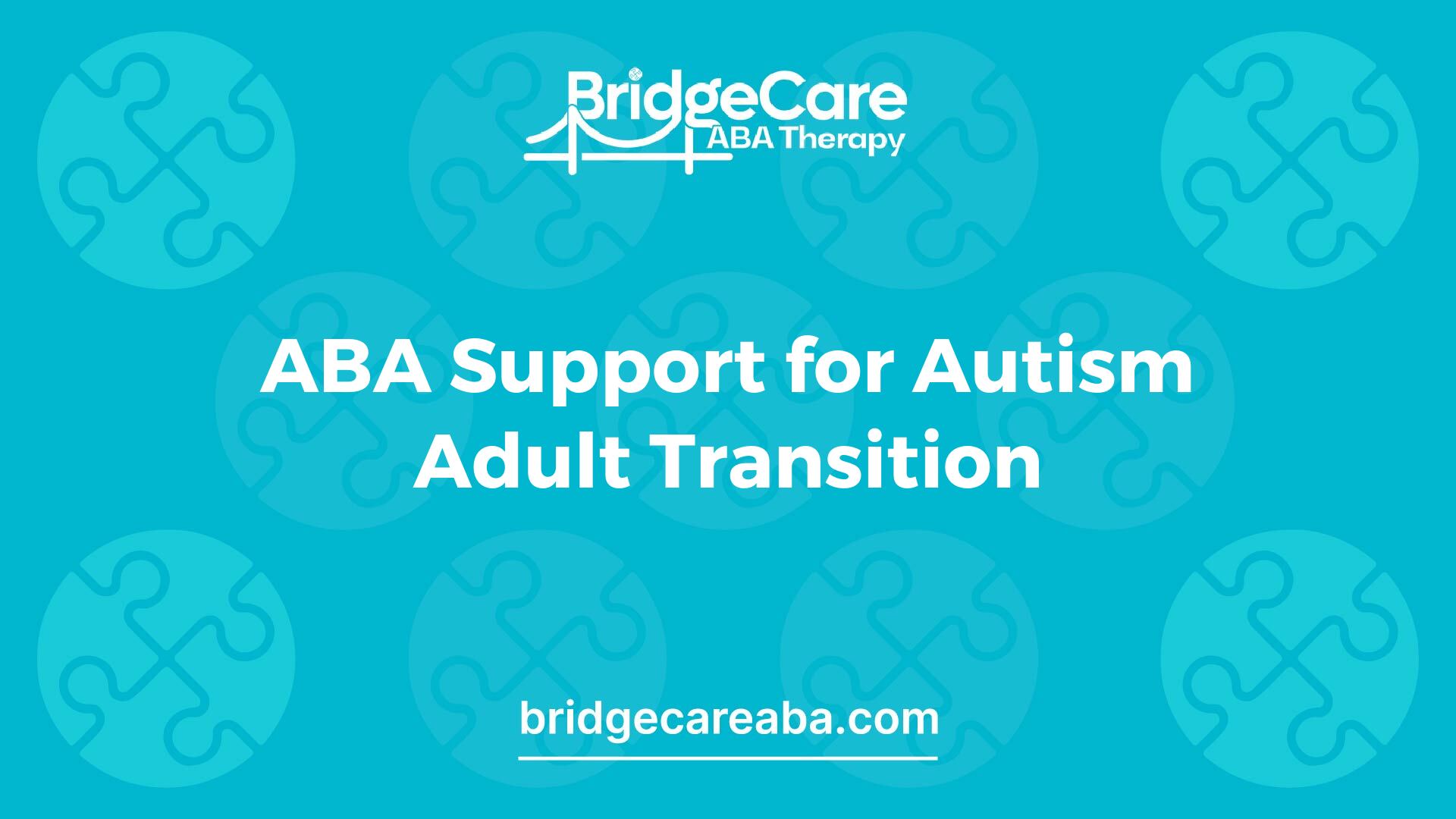ABA Support for Autism Adult Transition
Discover how ABA for transitioning to adulthood in autism empowers independence and enhances skills for success.
ABA Support for Autism Adult Transition
Discover how ABA for transitioning to adulthood in autism empowers independence and enhances skills for success.
ABA Therapy for Transitioning
Transitioning to adulthood can pose unique challenges for individuals with autism spectrum disorder (ASD). ABA therapy has emerged as a supportive tool during this critical phase, helping to equip individuals with essential skills for independent living and reducing behavioral challenges.

Importance of ABA Therapy
ABA therapy plays a pivotal role in supporting individuals with autism during the transition to adulthood by emphasizing skill acquisition and minimizing behavioral challenges through a structured approach. This therapy is effective across various age groups, demonstrating significant improvements in outcomes for individuals with autism and related developmental disorders.
A collaborative framework involving therapists, parents, and educational institutions is key to enhancing the implementation of ABA. This teamwork fosters a smooth transition plan that addresses academic, social, and vocational needs. Such an approach ensures that individuals not only acquire necessary life skills but also receive continuous support in their new environments.
As young adults exit high school, they frequently experience a loss of services and support systems, which can hinder their ability to maintain social connections and find appropriate resources. Therefore, a comprehensive transition plan that involves collaboration between family members, educators, and community organizations is crucial for ensuring a successful adulthood transition [2].
Bright Beginnings Program
The Bright Beginnings Program is an innovative initiative aimed at providing structured support for adolescents with autism as they prepare for adulthood. This program incorporates ABA therapy principles to equip young adults with vital skills needed for independent living and everyday interactions.
The program focuses on several key areas of development:
Skill AreaDescriptionDaily Living SkillsTeaching essential tasks such as shopping, cooking, and personal hygiene.Social SkillsDeveloping abilities to interact with peers and build relationships.Vocational SkillsProviding training for job readiness and appropriate workplace behaviors.
Through the Bright Beginnings Program, participants engage in practical, scenario-based training sessions that replicate real-life challenges. This allows them to practice newly acquired skills in a supportive environment.
The integration of ABA therapy into programs like Bright Beginnings highlights the importance of structured support systems, ultimately enhancing the quality of life for individuals with autism as they transition into adulthood. For more insights, check additional resources on ABA techniques for daily routines or ABA for improving social skills.
ABA Therapy Benefits
ABA therapy offers numerous benefits for individuals with autism transitioning to adulthood. This section highlights two critical aspects: vocational training support and a collaborative approach to care.
Vocational Training Support
One of the significant advantages of ABA therapy is its focus on providing vocational training support. Therapy sessions include skill-building exercises, sensory accommodations, and techniques for navigating workplace dynamics. This comprehensive approach promotes successful integration into the workforce, enhancing employability for adults with autism [1].
Vocational Training ComponentsDescriptionSkill-BuildingSessions to develop specific job-related skillsSensory AccommodationsModifications to the work environment to assist sensory needsWorkplace NavigationTechniques to manage interactions and tasks in a job setting
These elements help improve job readiness, essential for facilitating meaningful employment opportunities.
Collaborative Approach
A collaborative approach is crucial in the context of ABA therapy. Adolescents and adults with autism often interact with multiple service systems, including developmental disabilities, vocational, and educational services. This interconnected framework requires effective collaboration among professionals in various fields to ensure comprehensive support.
Furthermore, individuals with autism may face barriers in accessing care, such as high service costs, insufficient knowledge among providers, and stigma. By fostering collaboration among healthcare providers, social services, and families, ABA therapy can facilitate smoother transitions into adulthood and mitigate these challenges [4].
In summary, the benefits of ABA therapy for transitioning into adulthood include robust vocational training support and a collaborative approach, enhancing opportunities for individuals with autism to thrive in their adult lives.
Challenges Faced by Young Adults
Transitioning into adulthood presents various challenges for young adults with autism. These obstacles significantly impact their ability to achieve independence and thrive in society. Two critical areas of concern are employment and education, as well as social isolation.
Employment and Education
Approximately 35% of young adults with autism have never worked or received postsecondary education within the first six years of graduating high school. This statistic highlights significant barriers in accessing both employment and further education opportunities [4].
Young adults with autism often experience unemployment or underemployment at a higher rate than individuals with other disabilities. Their challenges may include navigating the job market, preparing for interviews, and adapting to workplace environments. The need for research-based interventions and support programs is evident to promote successful employment outcomes for this population.
StatisticPercentageYoung adults with autism who have never worked or received postsecondary education35%Adults with autism experiencing underemploymentMore than other disabilities
Social Isolation
Social isolation is another prevalent challenge faced by young adults with autism. About one-half to two-thirds of adults with autism report having no close friendships, and fewer than half participate in social events within their communities [4].
Navigating social interactions can be particularly daunting for individuals on the spectrum. They may struggle with forming and maintaining friendships, compounded by social skills deficits and communication difficulties. Issues include interpreting body language, responding to facial expressions, understanding tone of voice, and processing abstract language [4].
Stigma surrounding autism also contributes to feelings of rejection and isolation, impacting healthcare access and social integration. Increased awareness and support are essential for improving outcomes and fostering connections among young adults with autism.
StatisticPercentageAdults with autism reporting no close friendships50% - 67%Adults participating in community social eventsLess than 50%
Addressing the challenges related to employment, education, and social isolation is vital for helping young adults with autism transition successfully into independent adulthood. Emphasizing support through tailored programs can facilitate better outcomes and enhance the quality of life for these individuals.
Enhancing Transition with ABA
ABA therapy plays a significant role in enhancing the transition to adulthood for individuals with autism. By focusing on skill acquisition and employing a structured approach, ABA therapy helps young adults build essential life skills necessary for greater independence.
Skill Acquisition Focus
The core objective of ABA therapy is to improve various skill sets essential for adult life. This includes not only communication skills but also social skills, personal hygiene, and financial management. Each area is targeted to enhance the individual’s capability to function independently in society.
The Bright Beginnings Program is particularly designed to support families during this critical time. It prepares individuals for the transition to regular ABA therapy sessions by ensuring they are equipped with the necessary skills for effective learning.
Skill AreaDescriptionCommunicationEnhancing verbal and non-verbal skillsSocial SkillsBuilding interactions and peer relationshipsPersonal HygieneTeaching self-care routinesFinancial ManagementManaging budgeting and expenses
Structured Approach
A structured approach within ABA therapy is vital for targeting key life skills effectively. It provides a framework that is both predictable and consistent, which is particularly beneficial for individuals with autism.
The structured environment allows individuals to practice skills in real-world scenarios, which improves retention and application. This approach tailors programs to meet individual needs, reinforcing learning through repeated and consistent practice. Various supportive techniques are also integrated into the structured plan, which can include the use of visual aids and behavioral interventions, ensuring that all aspects of daily living are addressed [5].
Research emphasizes the positive outcomes of this structured therapy, highlighting enhanced social interactions, improved communication abilities, and increased independence for individuals transitioning to adulthood [6].
Employing both a skill acquisition focus and a structured approach, ABA therapy serves as an indispensable resource for those with autism embarking on the journey to adulthood. The combination of these methods lays the groundwork for successful independent living and integration into society.
Research on Adult Autism
Understanding the challenges faced by adults with autism is critical, especially regarding service accessibility and the development of vocational soft skills. Research highlights the need for effective support strategies during transitions to adulthood.
Service Accessibility
Adults with autism often face difficulties in accessing appropriate services as they transition into adulthood. This leads to a significant drop in available services, a situation commonly referred to as the "service cliff" NCBI. Many individuals with autism struggle to find necessary support programs, which can directly impact their quality of life and independence.
Barriers to service access include:
The accessibility of services is essential for promoting successful outcomes for adults with ASD. Research-based interventions and support programs are necessary to address these gaps and facilitate smoother transitions into independent living.
Barrier to AccessDescriptionFunding IssuesInadequate funding limits available services for adults with autism.Provider AwarenessMany service providers lack knowledge of adult autism needs.StigmaStigmatization can lead to reduced healthcare access and social isolation.
Vocational Soft Skills
Employment outcomes for adults with autism illustrate a significant concern, as this population experiences higher levels of unemployment and underemployment compared to individuals with other disabilities Yellow Bus ABA. The cultivation of vocational soft skills, such as communication, teamwork, and problem-solving, plays a crucial role in enhancing job readiness and workplace success.
A focus on vocational training that incorporates ABA strategies can enable individuals to develop these essential skills. This helps bridge the gap between skill acquisition and real-world application in work environments:
By prioritizing the acquisition of vocational soft skills, ABA therapy can significantly improve job prospects for adults with autism and facilitate more successful transitions into the workforce. For more on skill development, check out aba for autism and development delays.
Strategies for Successful Transition
Navigating the transition to adulthood can be challenging for individuals with autism. However, there are effective strategies that can be employed to facilitate this important process. This section focuses on the use of visual aids and the application of ABA techniques to enhance successful transitions.
Visual Aids for Transitions
Visual aids play a crucial role in assisting individuals with autism during transitions. Many individuals with ASD may struggle with understanding verbal instructions, recognizing transition cues, or adapting to changes in routine [7]. Utilizing visual supports can help minimize anxiety and facilitate smoother transitions.
Type of Visual AidDescriptionBenefitsVisual SchedulesA list or chart showing the sequence of activitiesReduces anxiety and improves independenceTransition CardsCards with images or icons depicting the next activityProvides clear expectations and reduces confusionVisual TimersTimers that visually indicate how much time is left for an activityHelps with understanding time and prepares for transitions“Finished” BoxesContainers where individuals can place items after completing a taskReinforces the concept of completion and closure
Implementing these visual aids can decrease transition times and challenging behaviors, as well as build independence. By providing a clear visual representation of what to expect, the anxiety associated with changes can be significantly reduced.
ABA Techniques Application
Applied Behavior Analysis (ABA) techniques are also effective in supporting transitions for individuals with autism. These techniques involve systematic approaches that can be tailored to the specific needs of each person. They focus on enhancing communication, social skills, and adaptive behaviors.
Common ABA strategies that can be applied during transitions include:
Incorporating these ABA techniques can lead to improved transitions, as they provide structured support and clarity during times of change. Additionally, the focus on reinforcing positive outcomes encourages individuals to feel more confident and capable, making the transition to adulthood less daunting. For more specialized approaches, exploring resources on using ABA for teaching daily routines or developing organizational skills may be beneficial.
References
[2]:
[3]:
[4]:
[5]:
[6]:
[7]:







